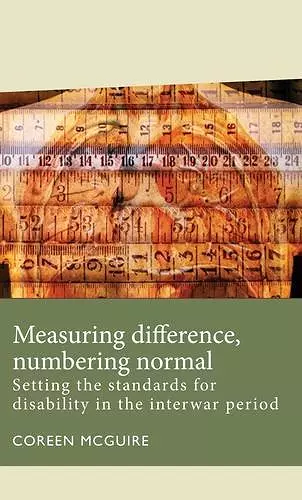Measuring Difference, Numbering Normal
Setting the Standards for Disability in the Interwar Period
Format:Hardback
Publisher:Manchester University Press
Published:11th Aug '20
Currently unavailable, and unfortunately no date known when it will be back

Measurements, and their manipulation, have been underestimated as crucial historical forces motivating and guiding the way we think about disability.
Using measurement technology as a lens, and examining in particular the measurement of hearing and breathing, this book draws together several existing discussions on disability, phenomenology, healthcare, medical practice, big data, embodiment, and emerging medical and scientific technologies around the turn of the twentieth century. These are popular topics of scholarly attention but have not, until now, been considered as interconnected topics within a single book. As such, this work connects several important, and usually separate academic subject areas and historical specialisms. The standards embedded in instrumentation created strict, but, ultimately arbitrary thresholds of what is categorised as normal and abnormal. Considering these standards from a long historical perspective reveals how these dividing lines shifted when pushed.
An electronic edition of this book is freely available under a Creative Commons (CC BY) licence.
'Measuring Difference, Numbering Normal is a valuable contribution to a vibrant discussion at the intersection of STS and disability studies, speaking directly to work by Lundy Braun, Mara Mills, and Jaipreet Virdi. It speaks too to STS work on quantification and the normalising of privileged bodies, as in the writings of Michelle Murphy and Jacqueline Wernimont.'
Social History of Medicine
'Measuring Difference, Numbering Normal is a complex work in that it deals with the construction of physical norms at the theoretical, historical, social and cultural levels. A very careful reading is necessary to grasp the richness of the references and sources used by the author to structure and deploy her arguments. This is indeed an ambitious book that seeks to measure the weight of the different actors – from doctors to engineers, from administrators to entrepreneurs – who participate in the development of standards of human physiology. This book highlights the erasure of users, whose expertise, although precious, is set aside and rarely solicited. It also reveals the consequences of these "arbitrary" but objectified norms on the construction of disability that result from a socially and culturally determined operation rather than from a series of scientifically rigorous observations. […] this remarkable work … can be considered an essential read for any historian and philosopher of science and technology, as well as for those interested in disability studies.'
Canadian Bulletin of Medical History, Corinne Doria
'What constituted a normal body in interwar Britain? Widely explored by scholars of eugenics, war, sexuality, and physical culture, McGuire skilfully turns this question to confront the figures and calculations used to define ‘normal’ and its inverse during this period.'
20th Century British History
McGuire's telling of history is engaging and thorough, providing colorful and, at times, emotive context to a wide range of organizations, products, and medical conditions.
H-Disability (January, 2024)
ISBN: 9781526143174
Dimensions: 216mm x 138mm x 16mm
Weight: 435g
248 pages